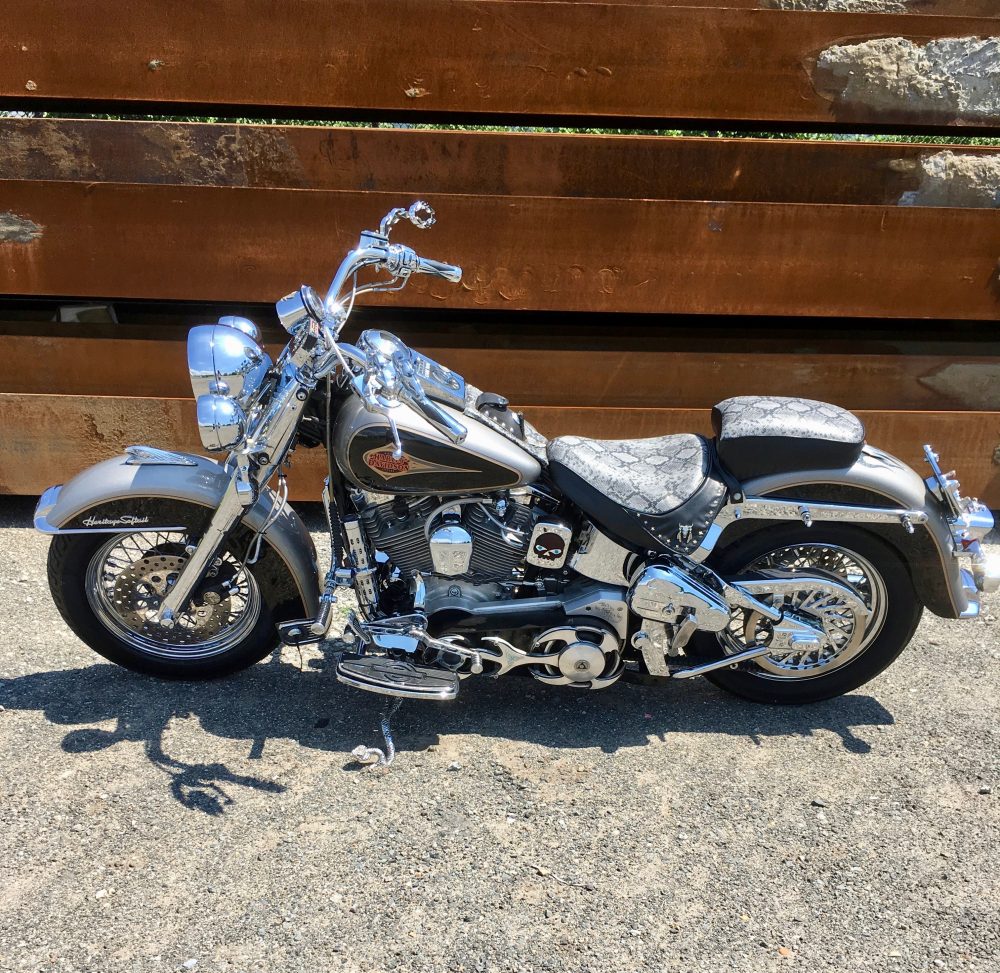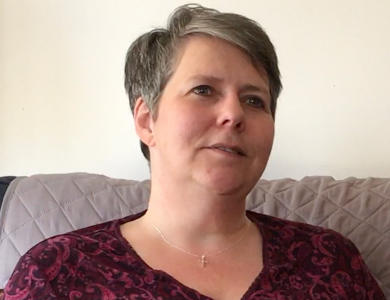LISTEN TO THIS ARTICLE:
Love at First High
Roy DeMauro met his True-Blue Friend in 1971. At eleven years old he was busy being the class clown, riding his bike down the middle of the street, and feeling invincible. Drinking was his first experience with substance use. Roy looked musingly as he recalled the experience, “Wow! This is great. One drink and I can be me. That feeling. That warmth. How could this be wrong?”
Roy was raised by a single, hard-working mom in a small town of about 30,000 just eleven miles outside of New York City. It’s a blue-collar town best known for its authentic fish and chips restaurants and its love of soccer. It had its beginnings in the late 1870s when the town burgeoned with thousands of Scottish immigrants who came to work in newly built textile mills. By the 60s and 70s, the manufacturing era had passed, and the mills stood silent, but Roy and so many other locals were anything but.
‘Down the meadows’
Like his peers, Roy hung out ‘down the meadows,’ as the locals called it, learned to ride a dirt bike while dreaming of a Harley, drifted in canals in makeshift boats, and played ‘chicken’ on the train tracks.
Roy was born a thrill-seeker. He recalls doing some pretty crazy things when he was young, like jumping off cliffs to swim in an abandoned quarry in 50-foot deep ice-cold water. Jutting rocks made this one of the most dangerous places to swim, and he’s got the scars to prove it.
Roy gave himself a tattoo by age twelve, and he always kept a half-pint of cheap booze in his cowboy boot to boost his confidence. Surrounded by lots of friends just like him, Roy was the quintessential ‘cool’ teenager. He had long blonde hair, sparkly green eyes, tattered blue jeans, cowboy boots, and apparent fearlessness.
Wild adolescence

By the time Roy got to high school, he and his pack would start their days smoking marijuana outside before class. Beer and vodka were daily staples. As time went on, Roy found himself taking increasingly harder drugs while opting for the easier classes.
His risk-taking behaviors continued as substances only enhanced his sense of fearlessness. His behaviors reached new levels of danger: unprotected sex, driving high, and crashing cars, to name a few. By the time he graduated (without learning how to read), he was regularly using heroin and all the cheap liquor he could get.
Roy recalls his first inkling that things might be out of control, “I remember thinking one day if this guy gets me two bags I might overdose with the amount of booze I had in my system.” And overdose he did. His mom found him in the bathroom turning colors. He was treated at the hospital and then put in jail.
People were dying of overdoses all around me, and I remember thinking, with the needle in my arm, if I don’t die, it will be a great high.
When cool goes wrong
In spite of the repeated warnings from doctors that his liver was failing and he would die, Roy couldn’t stop. By age 26, he was drinking to pass out, wake up, and drink again. “During the last couple of months of drinking, I was up to 10 bottles of Mad Dog 20/20 every day, starting at the crack of dawn.” His heroin use continued as well. Roy’s expression dropped as he told us of a poignant memory. “People were dying of overdoses all around me, and I remember thinking, with the needle in my arm, if I don’t die, it will be a great high.”
All this was taking a heavy toll on Roy’s body. Violent vomiting episodes eventually led to a ripped, bleeding esophagus that got him rushed to a hospital. He was becoming increasingly isolated; his true-blue friend had become his deadly enemy. Drowning in a bottle, it seemed almost a certainty that he would die. On the way to the hospital, he thought to himself, “How could something so cool go so wrong?”
While at the hospital, Roy was visited by two sharply-dressed men who would ultimately lead him to something life-changing. They spoke to him in a language he understood well. They’d been where he was. They offered help. Like so many in the throes of substance use disorders, his knee-jerk reaction was to think, “Why would they help me? Me with tattoos, long hair, piercings?”
It took tremendous self-reflection and pure grit to confront the reality that his uncontrollable substance use was killing him.
Those familiar with Alcoholics Anonymous will recognize this as ‘stinking thinking.’ People with substance use disorders tend to internalize the stigma with which they are so often treated, further eroding their sense of worth and making the already formidable effort needed for recovery seem pointless.
From jumping cliffs to climbing mountains
As is usually the case, it took several tries at detox before Roy’s recovery was able to gain traction. He eventually made it to a place called Graymoor that would help change him forever. A Holy Mountain Retreat run by Franciscan friars since 1878, Graymoor is located in a bucolic setting in upstate New York. After treatment and his time at Graymoor, he learned to listen to his inner spirit, and he began to lean into a higher power. It took tremendous self-reflection and pure grit to confront the reality that his uncontrollable substance use was killing him. In his sobriety, Roy learned that addiction impacts the mind, body, and spirit but that healing was possible.
For Roy, there was only one way out: he embraced the 12-step model completely. While the twelve-step approach worked for Roy, there are other options for those who don’t find this approach to be a fit. In Roy’s case, his AA support group became the new family that helped him build connections and a new identity.
After leaving Graymoor, Roy had the good fortune to receive a government grant to attend cooking school. Ironically, the school was located in the same neighborhood where he used to buy drugs. On the first day, he entered the building quickly before he could change his mind. Grateful for the opportunity, he never missed a single day of training to be a chef. Maintaining recovery meant that Roy needed to avoid triggers, avoid situations associated with using, earn money in responsible ways to support himself, and go to meetings every day. It sounds like a simple formula, but for many, it is nearly impossible to achieve. Roy constantly reminded himself his ‘True Blue Friend’ was, in reality, the worst kind of enemy, and that his new AA family was more than just a fellowship. Ultimately it is these connections that saved his life and now allow him to maintain his recovery.
A rock star is born
Roy still goes to visit the friars of St. Christopher’s Inn at Graymoor, where they continue to help men in crisis. He has brought many others there to heal as well. He has taken people who also once suffered from substance use disorders into his home to live with him and helped them maintain recovery. Roy posts his cell phone number on his web page for anyone seeking recovery information. He gives talks to the students at his former high school about the dangers of substance use and addiction.
A visitor to Roy’s website recently posted, “He is the rock star of recovery.” Roy gratefully reflects every day on what he feels is his mission: “My True-Blue Friend was my disease…and turned out to be my greatest enemy… my story is honest. Though it may seem sad, it also tells of the joys and happiness. I feel blessed…I’ve found my best self in recovery and in helping others.”
A visitor to Roy’s website recently posted, “He is the rock star of recovery.”
Finding stability
Working hard at his job of 25 years that he started right after he finished school, Roy is about to marry a woman he knew in elementary school. His life now may be simple, but it’s filled with joy and stability. Even when life throws challenges at him, he can cope in healthy ways and without substances. He proudly boasts 28 years sober.
Roy has made a great life for himself. As he looks at me smiling with those sparkling green eyes, he points out that he still wears blue jeans (though less tattered), cowboy boots, and long blonde hair. His dirt bike, however, has been replaced with a Harley. How cool is that? Roy survived the worst kinds of substance use disorders and discovered a new world that was right there all along.


 Learn
Learn Read Stories
Read Stories Get News
Get News Find Help
Find Help
 Share
Share
 Share
Share
 Share
Share
 Share
Share


